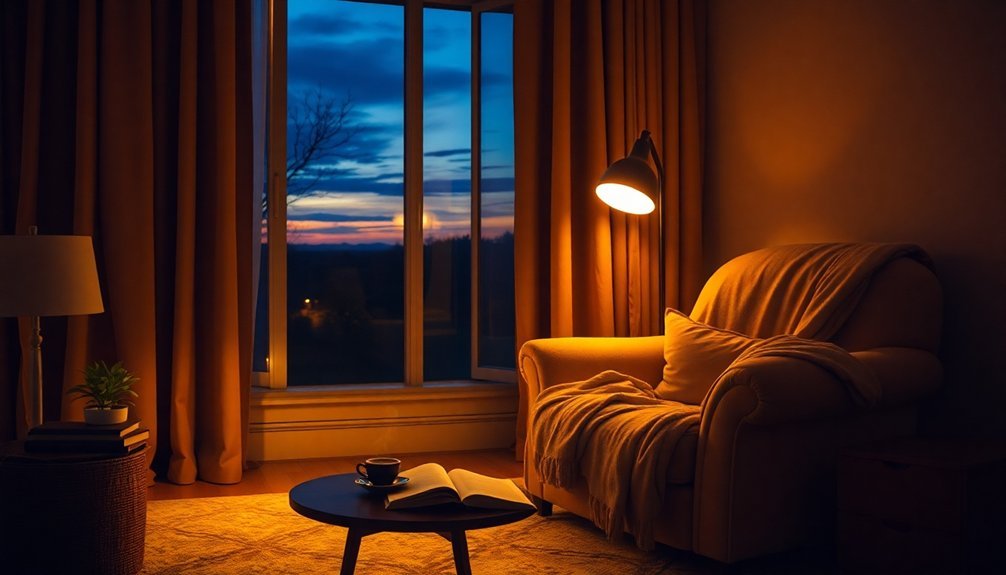For ideal evening infrared exposure, consider these five times: First, mimic a sunset to boost melatonin and relax before bedtime. Next, use an infrared sauna within 30 minutes after your workout to speed recovery. Incorporate it into your pre-bedtime relaxation routine about 30-60 minutes prior to sleep. Also, stick to a consistent schedule, aligning sessions with sunset to promote stress reduction. Finally, adjust your exposure based on personal health and environmental factors. Tailoring these strategies can enhance your well-being, and there's plenty more to discover about maximizing your infrared experience.
Sunset Simulation for Sleep

Sunset simulation can be a powerful tool for enhancing your sleep quality. By exposing yourself to sunset light, you can increase your melatonin levels, which is essential for shifting from wakefulness to sleepiness. Unlike harsh artificial lights that suppress melatonin production, simulated sunsets using tunable LED technology help boost these levels, promoting deeper, more restorative sleep.
Moreover, sunset simulation plays a critical role in regulating your circadian rhythm. The long-wavelength orange and yellow light typical of sunsets triggers specific neurons in your eyes, helping to set your body's internal clock. This natural change facilitates a smoother path to sleep and improves overall circadian health. Furthermore, effective systematic light and dark exposure is necessary to optimize sleep cycles and enhance the benefits of sunset simulation.
Implementing sunset simulation is straightforward with tunable LED technology. Start with regular indoor lighting and gradually dim the lights to mimic a sunset. This gradual adjustment not only supports relaxation but also minimizes any stress, allowing you to unwind efficiently.
If you struggle with sleep issues or circadian rhythm disorders, sunset simulation can be particularly beneficial. By committing to this natural lighting approach, you can achieve improved sleep duration and quality, setting the stage for a vibrant, well-rested day ahead.
Post-Workout Recovery Sessions
After focusing on the significance of sunset simulation for improving sleep quality, it's essential to contemplate the role of post-workout recovery sessions in your overall health regimen.
To maximize recovery benefits, aim to use the infrared sauna within 30 minutes to 1 hour after your workout. This timing optimizes your body's responsiveness, helping to reduce muscle soreness and improve your perceived recovery effectively. Additionally, the warmth from infrared exposure stimulates natural regenerative processes, further enhancing your recovery experience.
Spend about 20-30 minutes in the sauna, as this duration strikes the perfect balance without causing excessive strain. To experience the full array of benefits, keep the temperature around 43 ± 5°C. Longer sessions often don't provide any added advantages, and shorter ones may not activate your body's regenerative processes.
Physiologically, these sessions will enhance blood circulation, speed up muscle recovery, and reduce inflammation.
You'll notice improvements in muscle function, including better neuromuscular performance and reduced delayed onset muscle soreness (DOMS). With consistent use of infrared therapy, you can prevent that drop in explosive performance post-training, enabling you to return to your workouts sooner.
Incorporating this recovery strategy efficiently supports your fitness journey and overall well-being.
Pre-Bedtime Relaxation Routine

Creating a pre-bedtime relaxation routine is essential for signaling your body that it's time to wind down. You can enhance your bedtime experience by incorporating a few key activities into your routine. Aim for consistency by starting this routine 30 to 60 minutes before bed. Engaging in these activities can establish positive sleep associations that promote better rest.
Here are some relaxing activities you might consider:
| Activity | Purpose | Duration |
|---|---|---|
| Warm bath or shower | Cools body temperature | 20 minutes |
| Journaling | Clears mind of worries | 10-15 minutes |
| Gentle stretching/yoga | Releases muscle tension | 10 minutes |
| Mindfulness exercise | Calms the mind and body | 10 minutes |
Incorporate these practices regularly to reduce stress and improve overall sleep quality. Avoid screens and electronic devices at least an hour before bedtime to prevent blue light exposure. You'll find that making these slight adjustments helps create a calming atmosphere, allowing your mind and body to relax more easily. By forming a consistent pre-bedtime routine, you're setting the stage for a restful night's sleep.
Consistent Evening Scheduling
Establishing a consistent evening schedule plays an essential role in improving your sleep quality and overall well-being. By sticking to a routine, you enhance your body's melatonin production, signaling that it's time to wind down.
Incorporating red light therapy in your evening routine helps promote relaxation and reduces stress after a long day, allowing you to prepare for rest. Aim to schedule your sessions around sunset hours to align with your body's natural decline in light exposure. This timing aids in signaling the end of the day and supports your internal clock.
You'll find that consistent evening sessions—lasting up to 20 minutes—can also assist in repairing any damage incurred throughout the day, thanks to photobiomodulation. When timing your treatments, consider your physical activity levels. For best results, use red light therapy 3-6 hours before workouts for enhanced performance or right after to aid in recovery.
Be mindful to avoid bright red light close to bedtime, as it can interfere with melatonin production. Ultimately, by maintaining a structured evening schedule, you not only build cumulative benefits but also enhance your overall health and sleep quality.
Individualized Timing Adjustments

Individualized timing adjustments can considerably enhance the effectiveness of evening infrared exposure. When you consider your personal health conditions, you might need to tweak your exposure times. For example, if you have skin sensitivity or chronic pain, shorter sessions may work better for you to avoid discomfort.
Near-infrared devices can typically be used for up to 10 minutes a few times a week for hair growth or pain relief, but don't hesitate to adjust based on how you feel.
Environmental factors matter too. If it's hot where you are, shorter exposure times are essential to prevent heat strain. In contrast, cooler environments allow for longer sessions without discomfort.
Additionally, different infrared devices come with specific exposure guidelines based on their irradiance levels. Always follow manufacturer recommendations to guarantee safety and efficacy.
Lastly, find a balance between duration and frequency. Shorter daily sessions may benefit you more than less frequent, longer ones. Remember to listen to your body and adjust your timing to maximize the benefits while minimizing risks.
Frequently Asked Questions
Can Red Light Therapy Improve Mood and Reduce Anxiety?
Red light therapy boosts your mood by enhancing serotonin levels and triggering endorphins. It can reduce anxiety by promoting relaxation, regulating sleep patterns, and lowering stress, making you feel calmer and more balanced overall.
Is Red Light Therapy Safe for Children?
Red light therapy isn't universally safe for children. You should closely monitor treatment duration and intensity, ensuring sessions are supervised by healthcare professionals. Always use protective goggles and stop if any irritation occurs.
How Long Should Each Session Last for Best Results?
For best results, your sessions should typically last between 10 to 20 minutes. Start with shorter durations, around 5 to 10 minutes, and gradually increase as you become more comfortable with the treatment.
Can I Use Red Light Therapy on Sensitive Skin?
Yes, you can use red light therapy on sensitive skin, but start with shorter sessions to gauge your skin's reaction. Gradually increase duration while monitoring for irritation, and consult a healthcare professional if unsure.
Are There Any Side Effects of Using Red Light Therapy?
Yes, using red light therapy can cause side effects like skin irritation, burns, or eye damage if not used properly. Always follow guidelines, wear protective goggles, and consult a healthcare provider for safe use.
In Summary
Incorporating evening infrared exposure into your routine can enhance your well-being in various ways. By aligning sessions with sunset and workouts, or integrating them into your pre-bedtime relaxation, you set the stage for better sleep and recovery. Sticking to a consistent schedule helps your body adapt, while allowing for personalized adjustments guarantees you're getting the greatest benefit. Embrace these ideal times, and you'll likely notice a positive shift in your overall health and relaxation.





Leave a Reply